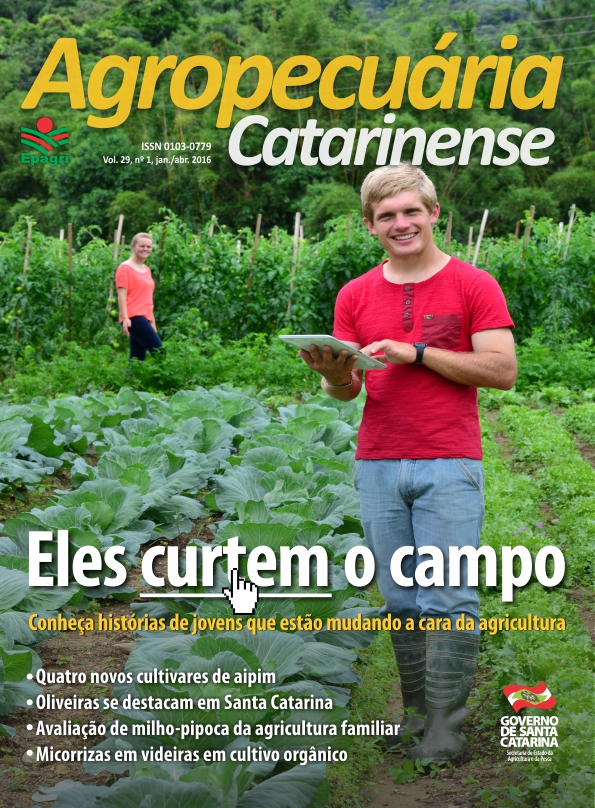The nutraceutical value of the onion
Keywords:
onion, health, food, medicinal.Abstract
The onion is a major source of antioxidants between fruits and vegetables consumed in the Brazil. The nutraceutical importance of the onion is mainly due to the antioxidants such as quercetin and thiols. These substances have an effect in reducing inflammation, allergies, viral diseases, cancer prevention, cardiovascular diseases and cataracts. The cultivar of onion developed by Epagri, Bola Precoce, presented relatively high quercetin content in analysis conducted by CNPH, EMBRAPA. Epagri conducted analyzes of the mineral composition of onion bulbs produced in Ituporanga Experimental Station and by some farmers in the region of the Alto Vale do Itajaí, Santa Catarina State, Brazil. The mineral nutrient content in the bulbs were higher than those presented in the Brazilian Table of Composition of Foods. Therefore, the quality of the onion produced in this region regarding the mineral aspects was satisfactory.Metrics
Publication Facts
Reviewer profiles N/A
Author statements
- Academic society
- Epagri - Revista Agropecuária Catarinense
- Publisher
- Empresa de Pesquisa Agropecuária e Extensão Rural de Santa Catarina - Epagri
References
ALMEIDA, A.; SUYENAGA, E.S. Ação farmacológica do alho (Allium sativum L.) e da cebola (Allium cepa L.) sobre o sistema cardiovascular: revisão bibliográfica. Nutrire, São Paulo, v.34, n.1, p.185-197, 2009.
ANJO, D.F.C. Alimentos funcionais em angiologia e cirurgia vascular. Jornal Vascular Brasileiro, Porto Alegre, v.3, n.2, p.145-154, 2004.
BOTREL, N.; OLIVEIRA, V.R. Cultivares de cebola e alho para processamento. In: CONGRESSO BRASILEIRO DE OLERICULTURA, 52.,
, Salvador, BA. Resumos... Brasília, Associação Brasileira de Horticultura, 2012.
BOOTS, A.W.; HAENEN, G.R.M.M.; BAST, A. Health effects of quercetin: from antioxidant to nutraceutical. European Journal of Pharmacology, v.585, p.325-337, 2008.
CARVALHO, P.G.B.; MACHADO, C.M.M. Sistema de produção de cebola (Allium cepa L.): Características nutricionais e funcionais. Embrapa Hortaliças. Sistemas de Produção, 5. Versão Eletrônica, 2004. Disponível em: <http://www.cnph.embrapa.br/sistprod/cebola/caracteristicas_nutricionais.htm>. Acesso em: 7 abr. 2011.
GALDÓN, B.R.; RODRÍGUEZ, C.T.; RODRÍGUEZ, E.M.R. et al. Fructans and major compounds in onion cultivars (Allium cepa). Journal of Food Composition and Analysis, v.22, p.25-32, 2009.
GONÇALVES, P.A.S.; VIEIRA NETO, J.; LINDNER, G.H. et al. Assessoria na avaliação da qualidade nutricional de bulbos de cebola produzida por agricultores orgânicos do Alto Vale do Itajaí, SC. In: CONGRESSO BRASILEIRO DE AGROECOLOGIA, 7., 2011, Fortaleza, CE. Resumos... Porto Alegre, RS: ABA Associação Brasileira de Agroecologia, 2011.
IBGE. Pesquisa de orçamentos familiares, 2008-2009. Aquisição alimentar domiciliar completa: Disponível em: <http://www.ibge.gov.br/home/estatistica/populacao/condicaodevida/pof/2008_2009_aquisicao/default_zip.shtm>. Acesso em: 8 mar. 2013.
MELO, E.A.; MACIEL, M.I.S.; LIMA, V.L.A.G. et al. Capacidade antioxidante de hortaliças usualmente consumidas. Ciência e Tecnologia de Alimentos, Campinas, v.26, n.3, p.639-644, 2006.
MURAKAMI, A.; ASHIDA, H.; TERAO, J. Multitargeted cancer prevention by quercetin. Cancer Letters, v.269, p.315-325, 2008.
OLIVEIRA, V.R. Cebola doce. Horticultura Brasileira, Brasília, v.22, n.1, s.p., 2004.
SCHUNEMANN, A.P.; TREPTOW, R.; LEITE, D.L. et al. Pungência e características químicas em bulbos de genótipos de cebola (Allium cepa L.) cultivados no Alto Vale do Itajaí, SC, Brasil. Revista Brasileira de Agrociência, Pelotas, v.12, n.1, p.77-80, 2006.
TACO. Tabela brasileira de composição de alimentos. Unicamp/Nepa. 4.ed. Campinas, SP: Unicamp/Nepa, 2011. 161p. Disponível em: <http://www.unicamp.br/nepa/taco/contar/taco_versao2.pdf>. Acesso em: 8 abr. 2011.
Downloads
Published
How to Cite
Issue
Section
License
Copyright (c) 2016 Revista Agropecuária Catarinense

This work is licensed under a Creative Commons Attribution 4.0 International License.





